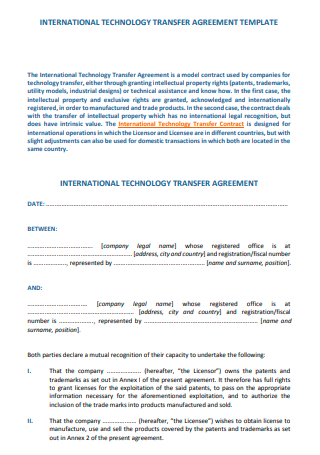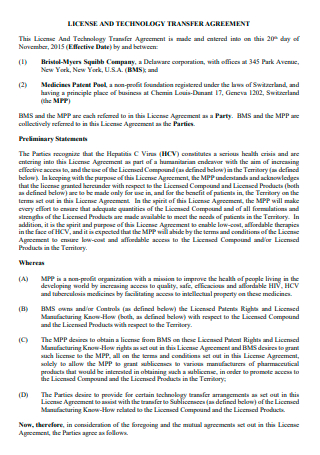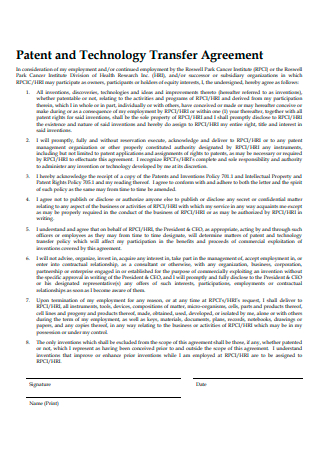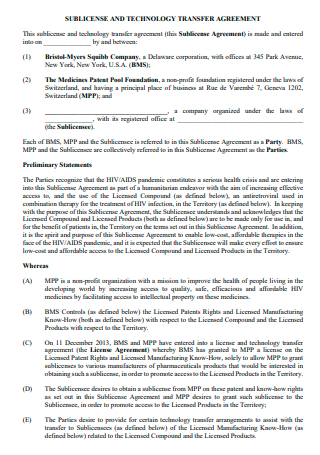3+ Sample Technology Transfer Agreement
FREE Technology Transfer Agreement s to Download
3+ Sample Technology Transfer Agreement
What Is a Technology Transfer Agreement?
Benefits of Technology
Tips for Technology Transfer Professionals
How to Process Technology Transfer
FAQs
How is technology transferred from one country to another?
What is the main purpose of transfer?
What is the impact of transfer learning?
What Is a Technology Transfer Agreement?
It is frequently referred to as the transfer of intellectual property from one company to another and is considered one of the general methods of transferring via a licensing agreement. For a fee, the licensee is granted unrestricted use of the technology for a predetermined time. It covers intellectual property rights, technical support, and licensing of package information, among others. The licensee can start producing and distributing goods in a defined area using the licensor’s technology.
Benefits of Technology
Present-day technology has made life more comfortable and convenient. It is an indispensable component of every modern workplace. In this dynamic environment, a company cannot live without technology; therefore, the advantages of technology in the workplace should be adequately recognized and acknowledged. Innovative technology, whether hardware or software, is a requirement in contemporary business. Whether or not your office is automated, you must familiarize yourself with the advantages of a technologically advanced workplace. Let’s have a look:
Tips for Technology Transfer Professionals
Earlier, we addressed the significance of technology and defined a technology transfer agreement. Now is the moment to leave behind your computer and cultivate the relationships that will help you achieve your maximum achievement. Some of these tips include direct networking, while others are called “seed networking,” in which your efforts are planted to be sown later. If you want to affect your stakeholders, you must invest time in networking and forming these vital connections.
1. Make Reading a Physical Activity
You have undoubtedly read extensively about research and development’s academic and business aspects. If an article moves you – perhaps you want more information or want to express your appreciation – you should contact the author. Frequently, stories include a social media handle or email address in the byline. Share your thoughts on the article and communicate with the author. This tiny action can initiate a networking relationship.
2. Follow Your Stakeholders
To connect with someone, meet them where they are most at ease. This may involve a meet-and-greet for researchers, a networking event for IT professionals, or something else. However, you do not wish to wait for occurrences. Create your own by making yourself available wherever your stakeholders are if none is imminent. Introduce yourself to new researchers or R&D professionals on the corporate side. You can even do this virtually for individuals who live far away.
3. Focus on the Goal
In movies, serendipity is lovely, but leaving your networking to chance is detrimental to your career. If you’re attending a conference or event and have access to the guest list, prepare a plan for who you want to meet and where you know they’ll be, such as at a specific session (because they’re speaking). Creating a networking objective will keep you focused and allow you to maximize your time at the event. Even if no event is planned, determining who you wish to meet makes it more accessible. You can utilize social media to track a person’s career and professional publications and devise a strategy for introducing yourself outside of an event. If you share a coworker, you should request an introduction.
4. Be Remarkable, Obtain Notice
Every comedian requires a shtick, just as actors and characters need props. While it may seem trivial, there are numerous benefits to sticking out from the crowd by wearing a specific color or accessory. It allows people to see you (and point others in your direction) from across the room, and your item may act as a conversation starter. Additionally, colors can attract or repel.
5. Be Open to Compliments
Frequently, we withhold our compliments. In a networking environment, now is the moment to capitalize on them. Compliment coworkers on their performance reports. Follow praise for an article with a query for clarification. They will feel valued and respected, and they will enjoy the talk. The purpose of networking is to make an impression. With a bit of preparation, you can shine at events. Still, the most effective networker can use the ability to make people feel comfortable in their presence to extend their professional relationships.
How to Process Technology Transfer
For many academics, their institution’s website is the initial and primary point of contact throughout technological commercialization. Ensure that all pertinent material is readily available and presented comprehensibly to promote academic engagement. The process of technology commercialization can appear confusing to an outside observer; therefore, it is essential to deliver all necessary facts efficiently and effectively. If you are still interested, the processes below can be followed.
1. Ensure That the Essential Information Is Easily Accessible on Your Institute’s Website
It frequently needs to be made clear where the commercialization team or office is within an institution’s organizational structure, making it challenging to locate the office on its website. Additionally, it is essential to indicate which sections of the website are for academics and the industry. When it comes to intellectual property, working with too many external partners can be a barrier; therefore, a brief description of how your office engages with the institute can alleviate worries. Similarly, consortiums can benefit knowledge and resource sharing, especially for smaller institutions. Although the structure and purpose may be evident to those who work within them, it is helpful to establish this from the outset to avoid confusion later on.
2. Introduce Technology Commercialization
Those unfamiliar with Technology Transfer as a process may only be aware that they own a relevant technology if they are familiar with the fundamentals. We advise providing the fundamentals and a more detailed overview of the procedure you follow immediately on your website, with connections to additional resources. You might also produce a printable leaflet or infographic that describes some of the institution’s finer points. If you have brochures or pamphlets available for your office, we suggest making them downloadable so they may be viewed and read offline. We acknowledge that this may entail additional effort. Still, the initial time commitment is well worth it to produce high-quality material that can be utilized consistently by your office and researchers.
3. Provide Some Fundamental Details on Patent Law
We know that patent law and intellectual property are complicated subjects; however, presenting academics with the fundamentals guarantees that you can have the appropriate talks in the proper stage of the commercialization process. Different institutions handle intellectual property in various ways; therefore, academics who have collaborated with commercialization teams at other schools can benefit from having this talk at the outset of the process to ensure that everyone feels confident moving forward.
4. Ensure That All Necessary Forms Are Available
Unavoidably, there will be many hoops to jump through, but there are a few easy steps to secure the process goes as smoothly as possible. First, ensure that all the forms an academic may require can be accessed on a single, well-marked page on your website. Ensure that all forms contain the relevant labels and titles and a brief description of why and when necessary. In addition, we recommend having finished examples of each structure with commentary on atypical cases. For instance, indicate which fields are required and what the author should do if they are missing specific information. Include information on how to convert the files if you need the form to be delivered in a particular format, and be sure to include clear directions on how and where to submit the completed request forms.
FAQs
How is technology transferred from one country to another?
Licensing, foreign direct investment, and joint venture agreements are essential legitimate pathways for technology transfer. Most technology transfer occurs through licensing under terms and conditions agreed upon by both suppliers and recipients.
What is the main purpose of transfer?
A person moves horizontally or laterally from one position, section, department, work shift schedule, or plant to another while maintaining the same salary, rank, and responsibilities, either at the same or a different location.
What is the impact of transfer learning?
The results demonstrated that learning transfer activities enhanced skill application and performance plan outcomes. When comparing those who received training with learning transfer activities to those who received training program proposal alone, skill application was over 100 percent higher, and performance impact was 48 percent greater for those who received training plus learning transfer activities.
The technology transfer agreement is crucial to the development and growth of the technology, which could improve the economy of the country or state. Check some of the technology transfer agreement samples offered for your reference in the post for more examples and formats.




